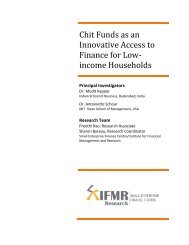Government of India Volume I: Analysis and Recommendations
Government of India Volume I: Analysis and Recommendations
Government of India Volume I: Analysis and Recommendations
You also want an ePaper? Increase the reach of your titles
YUMPU automatically turns print PDFs into web optimized ePapers that Google loves.
FINANCIAL REGULATORY ARCHITECTURE<br />
Table <strong>of</strong> <strong>Recommendations</strong> 14.2 Financial regulatory architecture envisaged by the<br />
Commission<br />
Present Proposed<br />
(1) RBI (1) RBI<br />
(2) SEBI<br />
(3) FMC<br />
(4) IRDA (2) Unified Financial Authority (UFA)<br />
(5) PFRDA<br />
(6) SAT (3) FSAT<br />
(7) DICGC (4) Resolution Corporation<br />
(5) FRA<br />
(6) Public Debt Management Agency (PDMA)<br />
(8) FSDC (7) FSDC<br />
Avoiding sectoral regulators: When a financial regulator works on a sector, there is<br />
a possibility <strong>of</strong> an alignment coming about between the goals <strong>of</strong> the sector (growth <strong>and</strong><br />
pr<strong>of</strong>itability) <strong>and</strong> the goals <strong>of</strong> the regulator. The regulator then tends to advocate policy<br />
directions that are conducive for the growth <strong>of</strong> its sector, which might be at the cost <strong>of</strong><br />
overall consumer protection. Such problems are less likely to arise when a regulatory<br />
agency works towards an economic purpose such as consumer protection across all, or<br />
at least, many sectors.<br />
Economies <strong>of</strong> scale in <strong>Government</strong> agencies: In <strong>India</strong>, there is a paucity <strong>of</strong> talent<br />
<strong>and</strong> domain expertise in <strong>Government</strong>, <strong>and</strong> constructing a large number <strong>of</strong> agencies is<br />
relatively difficult from a staffing perspective. It is efficient to place functions that require<br />
correlated skills into a single agency.<br />
Transition issues: It is useful to envision a full transition into a set <strong>of</strong> small <strong>and</strong> implementable<br />
measures.<br />
14.4. A financial regulatory architecture suited for <strong>India</strong>n<br />
conditions<br />
The Commission proposes the following structure, featuring seven agencies.<br />
Agency #1: The RBI, which formulates <strong>and</strong> implements monetary policy, <strong>and</strong> enforces<br />
consumer protection <strong>and</strong> micro-prudential provisions <strong>of</strong> the draft Code in the fields <strong>of</strong><br />
banking <strong>and</strong> payment systems.<br />
Agency #2: The UFA, which enforces the consumer protection <strong>and</strong> micro-prudential<br />
provisions <strong>of</strong> the draft Code across the financial sector, other than in banking <strong>and</strong> payment<br />
systems.<br />
Agency #3: A resolution corporation, which implements the provisions on resolution<br />
<strong>of</strong> financial firms in the draft Code.<br />
Agency #4: The FSAT, which hears appeals against all financial regulatory agencies.<br />
Agency #5: The FRA, which addresses consumer complaints across the entire financial<br />
system.<br />
Agency #6: The FSDC, which will be responsible for systemic risk oversight.<br />
Agency #7: The PDMA, an independent public debt management agency.<br />
The table summarises the changes in the financial regulatory architecture that will<br />
be proposed. These changes will alter the <strong>India</strong>n financial l<strong>and</strong>scape from eight financial<br />
regulatory agencies to seven.<br />
FINANCIAL SECTOR LEGISLATIVE REFORMS COMMISSION 133



